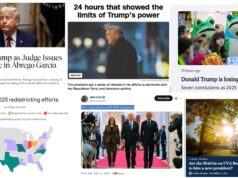by Ivy Main, cross-posted from her great blog, Power for the People VA
On Sunday the U.S. Senate passed the historic climate legislation package hammered out between Senate Majority Leader Chuck Schumer and West Virginia Senator Joe Manchin. The House is expected to follow suit this week, giving President Joe Biden a huge win on one of his administration’s priorities and finally making good on his pledge to tackle climate change.
The bill is titled the Inflation Reduction Act (IRA), apparently because the senators think inflation is the only thing most Americans care about right now. But whether it reduces inflation is beside the point. The IRA marks the federal government’s most significant investment in clean energy and transportation ever. Its $370 billion of climate spending will cut U.S. emissions roughly 42% below 2005 levels by 2030, only slightly less than the reductions that would have been achieved through Biden’s signature Build Back Better bill.
This is a huge piece of legislation, though, and some of the compromises Schumer was forced to make are not climate-friendly. Manchin, after all, is a coal baron representing a state so dominated by the extraction industries that it has lost sight of any other future. Climate hawks have to hold their noses (beaks?) to accept some noxious provisions, such as the bill’s requirement for new offshore drilling lease sales. No doubt that one will cheer motorists who wrongly assume the government could lower gasoline prices just by turning on a spigot, if only it wanted to.
The bill also comes with a side deal meant to ensure completion of the Mountain Valley Pipeline, which starts in Manchin’s home state. That news promptly soured many activists in Virginia on the whole package.
Hang in there, people. The pipeline deal isn’t actually part of the IRA, and Manchin knows better than anyone that a promise of some second bill to be voted on in the future is a castle in the air. Maybe he’ll get it, maybe he won’t. Meanwhile, the IRA’s incentives for renewable energy, energy storage, energy efficiency, building electrification and electric vehicles are overwhelmingly more impactful than provisions designed to increase oil and gas production. The business case for new pipelines will only get worse.
Three recurring themes stand out in the IRA. One is the attention paid to ensuring benefits flow to low- and moderate-income residents and communities impacted by fossil fuel extraction. A second is the effort to incentivize manufacturing and supply chain companies to bring operations back to the U.S., using tax credits for manufacturing and requirements for U.S.-made components. The third is job creation and training for career jobs that pay well. The combined effect is that the law will benefit former coal workers in Southwest Virginia looking for employment at least as much as Northern Virginia suburbanites jonesing for Teslas.
Every state will see clean energy investments soar if the bill becomes law, but Virginia is especially well positioned. Though we have embarrassingly little wind and solar in our energy mix today, we have huge potential for both, a strong tech sector and a well-educated workforce.
Just as important, laws passed by the General Assembly in the past few years already provide the framework for our energy transition. Among them, the Virginia Clean Economy Act and participation in the Regional Greenhouse Gas Initiative are pushing our utilities to decarbonize, including through investments in energy efficiency, solar and offshore wind. Solar Freedom removed barriers to private investments in distributed solar, while the Grid Modernization Act authorized upgrades to the distribution grid, and the Clean Cars Act started us down the road to vehicle electrification. For all of these, the IRA’s incentives make compliance easier and less expensive for both utilities and customers.
Renewable energy tax credits with an emphasis on equity and jobs

The IRA is a big bill with a lot of fine print detailing incentives for a wide range of technologies, mostly clean but with a few clunkers. (Hydrogen made from fracked gas, anyone?) Still, the largest share of the renewable energy tax credits will go to companies involved in the wind and solar industries. The credits will remain fixed for 10 years before ramping down, finally providing the business certainty and long planning window that clean tech companies have been begging for.
The more utilities take advantage of the law to install renewable energy, the greater the benefit to electricity customers. Renewable energy helps stabilize electricity costs, dampening the impact of high fossil fuel prices. The IRA’s tax credits will lower the cost of building wind and solar, saving money for Virginia customers as our utilities meet and exceed the VCEA’s targets for solar, storage and wind. (So, yes, the Inflation Reduction Act will live up to its name when it comes to electricity prices.)
For utility-scale projects like solar farms and offshore wind, obtaining the maximum tax credit requires that a steadily increasing percentage of the equipment used be American made. Credits available to manufacturers are intended to draw the supply chain back to the U.S. and will help those parts be cost-competitive. New prevailing wage and apprenticeship program requirements favor union labor and middle-class incomes for careers in green energy.
While large renewable energy facilities will contribute most to decarbonizing the grid, the most generous incentives in the IRA are reserved for distributed generation facilities under 1,000 kilowatts AC (1,300 kW DC), a category that includes most rooftop solar. For these projects, the investment tax credit will return to 30% for the next 10 years, with adders available if the facility is located on a brownfield or in an “energy community” (10%), uses domestic content (10%) or serves low-income residents (10-20%). The credits can be combined, making it entirely possible for a solar project on low-income housing in Virginia’s coalfields, built using American-made equipment, to qualify for tax credits of up to 70% of the cost.
Not only that, but taxpayers will be allowed to sell the credits, so people with no tax liability can still take advantage of the discounts. This feature will make solar affordable for homeowners who don’t owe enough in federal taxes to use the tax credits themselves. It will also make it possible for installers to discount the upfront cost of a solar array by the amount of the tax credit so customers don’t have to wait months for a tax refund.
A final feature is that the tax credits will now also be available as direct payments to tax-exempt entities like local governments, schools and churches. Direct pay will have the biggest impact in states that don’t allow third-party power purchase agreements (PPAs), but it’s a great option anywhere.
The “adder” for brownfields will be of interest to many Virginia localities that want to find ways to safely use closed landfills and old industrial sites, while Virginia’s government has already identified brownfields as a great opportunity for solar.
But the biggest market opportunities would seem to be for solar on low-income housing and in areas impacted by fossil fuel extraction. Carrie Hearne, associate director for renewable energy and energy efficiency at Virginia’s Department of Energy, said the many federal funding programs laid out in the IRA “would provide great opportunities for energy infrastructure investments in communities that are most in need, and in turn, help to lower energy bills. These federal funds could also contribute to the commonwealth’s goal of competitive rates, reliable and responsible delivery of energy alongside rural economic development.”
To understand how the solar industry sees these opportunities, I called the leaders of three solar companies that develop onsite solar in low-income areas and in the coalfields: Dan Conant of West Virginia-based Solar Holler, Tony Smith of Staunton-based Secure Futures and Ruth Amundsen of Norfolk Solar. Not surprisingly, they all predicted stunning growth in both distributed solar and jobs as a result of the IRA.
Solar has made fewer inroads in Southwest Virginia than in other parts of the state, which Conant sees as an opportunity. One of the few unionized solar companies in the area, and the only one I know of focused exclusively on Appalachia, Solar Holler has been expanding into Southwest Virginia and hiring workers at a steady clip. (Disclosure: I own a tiny stake in Solar Holler.)
The company already uses American-made components, so Conant said coalfields residents will be able to take advantage of two of the adders to install solar on their homes and businesses at half price, with low-income residents paying even less. The IRA’s manufacturing tax credits for American solar companies will further reduce the cost of the projects.
Conant was especially excited about the IRA’s impact on jobs in Appalachia. He expects to ramp up hiring significantly once the IRA becomes law. It took no prodding from me for him to add, “I truly believe this bill will let us get to 100% clean energy in 15 years.”
Secure Futures also has projects underway in Southwest Virginia as well as elsewhere across the state. The company uses third-party PPAs to allow tax-exempt customers like schools and nonprofits to go solar with no money down, paying just for the electricity produced by the panels. Although the IRA allows these customers to get the tax benefits without a PPA, Secure Futures president Tony Smith said tax-exempt entities will still do better using PPAs to take advantage of accelerated depreciation.
Smith said the IRA will make an already strong solar market in Virginia even stronger, as the higher tax credits will push down prices and the transferability of the credits will make it easier to attract more investors to solar. At the same time, a provision of the VCEA requiring Dominion Energy Virginia to acquire renewable energy certificates (RECs) from distributed generation facilities has created a strong market for these certificates, helping to finance projects and making solar even more affordable for institutional customers that sell their solar RECs.
On the other side of the commonwealth, Norfolk Solar also installs solar in low-income communities, offering PPAs to both commercial customers and low-income residents in economically distressed areas that qualify for special tax treatment as Qualified Opportunity Zones. (Under Virginia law, residential PPAs are available only to low-income customers.) Amundsen pointed out that the 10-year time horizon of the tax credits is an added benefit of the IRA to both her customers and potential investors because it allows for long-range planning and multi-year projects.
Energy storage will stand on its own
The VCEA established one of the most ambitious goals for energy storage development in the nation. But current federal law offers tax credits for energy storage only when it is part of a renewable energy project. The limitation has led to the proliferation of solar-plus-batteries projects around the country. It’s an ideal combination because it allows solar energy to be used when it is needed, unshackled from the time of day that it’s produced.
But uncoupling storage from renewable energy projects is a more efficient way to manage the grid, said Steve Donches, a Loudoun County attorney who represents battery storage companies and recently served on the Virginia Energy Storage Task Force.
“In many instances, the best location for storage supporting the grid is not where the renewables are located but rather near grid chokepoints or inside load pockets,” he said. “Moreover, site selection flexibility can often be important from a zoning permitting perspective. The new approach allows developers to be more nimble and locate where it is most useful and cost efficient.”
Recognizing this, the IRA provides a tax credit of up to 30% for energy storage whether or not it is part of a renewable energy facility.
This will make grid storage less expensive and easier for our utilities to install, and it will also benefit customers who want to put batteries in their buildings for back-up power. Amundsen noted that her customers sometimes can’t afford to include a battery at the time they install solar; the IRA will let them take the tax credit for storage even if they buy the battery later. This is especially important, she said, for resilience in low-income neighborhoods, where adding a battery to a solar-powered church or community center allows it to “island” during a power outage and provide a refuge for neighbors.
Homeowners will see huge benefits from building electrification
A cleaner electricity grid makes it possible to decarbonize other sectors of the economy by substituting electricity for fossil fuels in transportation and buildings; hence the climate advocates’ mantra “Electrify everything.” Yet while new electric appliances have become more energy efficient and attractive to consumers than the ones they replace, the switch comes with a price tag.
Under the new law, price will no longer be a barrier. The IRA offers rebates to residents to upgrade their homes with new electric technology such as heat pumps for heating and cooling (up to $8,000), electric induction stoves ($840), heat pump water heaters ($1,750) and upgrades to home electrical systems to support all the new load ($4,000). The rebates phase out for higher-income earners. Lower-income families replacing old and inefficient appliances will see the greatest energy savings as well as the highest rebates.
The federal rebates are a fantastic complement to existing Virginia programs for low-income energy efficiency upgrades. A major attraction of Virginia’s participation in the Regional Greenhouse Gas Initiative is the hundreds of millions of dollars it raises for low-income efficiency programs such as those devoted to upgrading multifamily housing like apartment buildings. Coordinating the state programs with the new federal rebates should be an urgent priority to ensure the broadest possible benefits to low-income Virginians.
Meanwhile, gas utilities had better start planning for the end of their business. There is no longer any reason to expand and upgrade gas distribution pipelines, because from here on in their customer base will be shrinking, not growing, resulting in stranded assets.
Electric vehicles aren’t just for the rich any more

The IRA provides a $7,500 EV tax credit for new vehicles, including those made by manufacturers like Tesla and Toyota that had reached volume caps in previous law. Restrictions apply, including income limits, vehicle price caps and supply chain sourcing rules. The act also now adds a credit of up to $4,000 for used vehicles, making ownership possible for more people at all income levels.
Virginia is committed to vehicle electrification through its adoption of clean cars legislation in 2021 and a 2022 law requiring state agencies to buy electric light-duty vehicles whenever the total cost of ownership is less than it would be for a vehicle with an internal combustion engines. But further speeding up the transition to EVs will create ripple effects requiring careful planning. Electricity demand will increase and do so unevenly, requiring load management programs and upgrades to parts of the distribution grid.
Charging all these vehicles will also be an issue. Many would-be EV customers lack the ability to charge at home, either because they don’t own the space where they park or because their homes aren’t wired for easy installation of a charger. The problem is especially acute for people who rent apartments in buildings that lack charging stations.
No matter how generous the credits, people won’t buy EVs if they can’t charge them. Virginia must require multifamily buildings to include enough charging stations for all the residents who want them, ensure public charging stations are plentiful and convenient in low-income neighborhoods and improve its residential housing code to ensure new homes are wired to facilitate installation of chargers.
For best results, lean in

Virginia law requires each new governor to produce an energy plan in October of the first year in office, so Virginia’s Department of Energy is currently in the process of writing a plan that will have Gov. Glenn Youngkin’s stamp on it. The plan must be one that “identifies actions over a 10-year period consistent with the goal of the Commonwealth Clean Energy Policy set forth in § 45.2-1706.1 to achieve, no later than 2045, a net-zero carbon energy economy for all sectors, including the electricity, transportation, building, agricultural, and industrial sectors.”
Governor Youngkin hasn’t shown much enthusiasm for Virginia’s energy transition to date, having tried to gut the VCEA and repeal RGGI. Yet with the IRA making so many incentives available for clean energy and electric vehicles, leaning in to the energy transition now will allow the commonwealth to reap huge rewards in the form of economic development, job growth, cleaner air and lower energy bills.
The opportunities for Virginia are enormous; the governor should make the most of them.
This article originally ran in the Virginia Mercury on August 9, 2022.
Dear readers: Many of you know that although I write independently of any organization, I also volunteer for the Sierra Club and serve on its legislative committee. The Sierra Club’s Virginia Chapter urgently needs funds to support its legislative and political work towards a clean energy transition. So this summer I’m passing the hat and asking you to make a donation to our “Ten Wild Weekends” fundraising campaign. Thanks!















